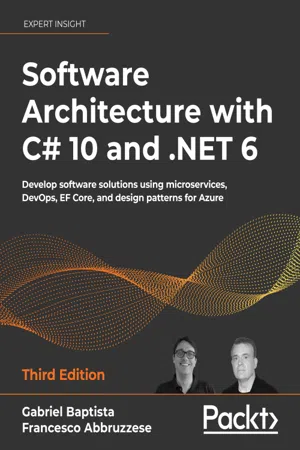
- 714 pages
- English
- ePUB (mobile friendly)
- Available on iOS & Android
Software Architecture with C# 10 and .NET 6
About this book
Design scalable and high-performance enterprise applications using the latest features of C# 10 and.NET 6Key Features• Gain comprehensive software architecture knowledge and the skillset to create fully modular apps• Solve scalability problems in web apps using enterprise architecture patterns• Master new developments in front-end architecture and the application of AI for software architectsBook DescriptionSoftware architecture is the practice of implementing structures and systems that streamline the software development process and improve the quality of an app. This fully revised and expanded third edition, featuring the latest features of.NET 6 and C# 10, enables you to acquire the key skills, knowledge, and best practices required to become an effective software architect. Software Architecture with C# 10 and.NET 6, Third Edition features new chapters that describe the importance of the software architect, microservices with ASP.NET Core, and analyzing the architectural aspects of the front-end in the applications, including the new approach of.NET MAUI. It also includes a new chapter focused on providing a short introduction to artificial intelligence and machine learning using ML.NET, and updated chapters on Azure Kubernetes Service, EF Core, and Blazor. You will begin by understanding how to transform user requirements into architectural needs and exploring the differences between functional and non-functional requirements. Next, you will explore how to choose a cloud solution for your infrastructure, taking into account the factors that will help you manage a cloud-based app successfully. Finally, you will analyze and implement software design patterns that will allow you to solve common development problems. By the end of this book, you will be able to build and deliver highly scalable enterprise-ready apps that meet your business requirements.What you will learn• Use proven techniques to overcome real-world architectural challenges• Apply architectural approaches such as layered architecture• Leverage tools such as containers to manage microservices effectively• Get up to speed with Azure features for delivering global solutions• Program and maintain Azure Functions using C# 10• Understand when it is best to use test-driven development (TDD)• Implement microservices with ASP.NET Core in modern architectures• Enrich your application with Artificial Intelligence• Get the best of DevOps principles to enable CI/CD environmentsWho this book is forThis book is for engineers and senior software developers aspiring to become architects or looking to build enterprise applications with the.NET Stack. Basic familiarity with C# and.NET is required to get the most out of this book.
Frequently asked questions
- Essential is ideal for learners and professionals who enjoy exploring a wide range of subjects. Access the Essential Library with 800,000+ trusted titles and best-sellers across business, personal growth, and the humanities. Includes unlimited reading time and Standard Read Aloud voice.
- Complete: Perfect for advanced learners and researchers needing full, unrestricted access. Unlock 1.4M+ books across hundreds of subjects, including academic and specialized titles. The Complete Plan also includes advanced features like Premium Read Aloud and Research Assistant.
Please note we cannot support devices running on iOS 13 and Android 7 or earlier. Learn more about using the app.
Information
17
Blazor WebAssembly
- Blazor WebAssembly architecture
- Blazor pages and components
- Blazor forms and validation
- Blazor advanced features, such as globalization, authentication, and JavaScript interoperability
- Third-party tools for Blazor WebAssembly
- Use case – implementing a simple application in Blazor WebAssembly
Technical requirements
Blazor WebAssembly architecture
Table of contents
- Preface
- Understanding the Importance of Software Architecture
- Non-Functional Requirements
- Documenting Requirements with Azure DevOps
- Deciding on the Best Cloud-Based Solution
- Applying a Microservice Architecture to Your Enterprise Application
- Azure Kubernetes Service
- Interacting with Data in C# – Entity Framework Core
- How to Choose Your Data Storage in the Cloud
- Working with Azure Functions
- Design Patterns and .NET 6 Implementation
- Understanding the Different Domains in Software Solutions
- Implementing Code Reusability in C# 10
- Applying Service-Oriented Architectures with .NET
- Implementing Microservices with .NET
- Presenting ASP.NET Core MVC
- Implementing Frontend Microservices with ASP.NET Core
- Blazor WebAssembly
- Native versus Web Clients
- Artificial Intelligence and Machine Learning
- Best Practices in Coding C# 10
- Understanding DevOps Principles
- Challenges of Applying CI & CD Scenarios
- Testing Your Enterprise Application
- Answers
- Other Books You May Enjoy
- Index